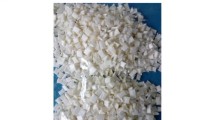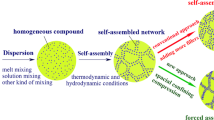Abstract
Injection-compression-compression (I-C-C) process was studied to prepare polypropylene/ short carbon fiber (PP/SCF) composites. The effects of I-C-C process on the conductive network, fiber distribution and electric conductivity were investigated. The distance between conductive particles of the blending system was reduced by two-stage compression, so that the conductive network was compacted. The forming of dense conductive network significantly improved the conductivity. Moreover, I-C-C can effectively interfere with the fiber flow direction to enhance the conductivity of the infiltrated surface. Combined with the microstructure and electrical conductivity, the applicable mold temperature and compression speed range of the I-C-C process for PP can be obtained. The results showed that the electrical conductivity of the I-C-C prepared PP/SCF was increased up to 5 orders of magnitude higher than that of ordinary injection molding. Conductivity of PP/ 10 wt% SCF conductivity reached 3.7S/m, PP /15 wt% SCF reached 33S/m, and PP/ 20% SCF reached 150S/m.








Similar content being viewed by others
References
Snook, G.A., Kao, P., Best, A.S.: Conducting-polymer-based supercapacitor devices and electrodes. J. Power Sources. 196(1), 1–12 (2011)
Thomassin, J.M., Jérôme, C., Pardoen, T., Bailly, C., Huynen, I., Detrembleur, C.: Polymer/carbon based composites as electromagnetic interference (EMI) shielding materials. Mater. Sci. Eng. R. 74(7), 211–232 (2013)
Anna, K., Dawid, J., Artur, P. H., Rafal, G.J., Tomasz, G., Sławomir, B.: From blackness to invisibility â Carbon nanotubes role in the attenuation of and shielding from radio waves for stealth technology. Carbon 126, 31-52 (2018).
Ezquerra, T.A., Bayer, R.K., Calleja, F.J.B.: Conductive PE-carbon black composites by elongational flow injection moulding. J. Mater. Sci. 23(11), 4121–4126 (1988)
Feller, J.F.: Smart conductive polymer composites for sensing applications. In: Gordon Research Conference – Composites (2009)
Antunes, R.A., Oliveira, M.C.L.D., Ett, G., Ett, V.: Carbon materials in composite bipolar plates for polymer electrolyte membrane fuel cells: a review of the main challenges to improve electrical performance. J. Power Sources. 196(6), 2945–2961 (2011)
Deng, H., Du, R., Duan, L., Fu, Q: Strain sensing conductive polymer composites: Sensitivity and stability. American Institute of Physics Conference Series. AIP Publishing LLC, (2016).
Nanni, F., Ruscito, G., Puglia, D., Terenzi, A., Kenny, J.M., Gusmano, G.: Effect of carbon black nanoparticle intrinsic properties on the self-monitoring performance of glass fibre reinforced composite rods. Compos. Sci. Technol. 71(1), 1–8 (2011)
Ding, T., Wang, L., Peng, W.: Changes in electrical resistance of carbon-black-filled silicone rubber composite during compression. J. Polym. Sci. B Polym. Phys. 45(19), 2700–2706 (2010)
Zhao, X., Wang, H., Fu, Z., Li, Y.: Enhanced interfacial adhesion by reactive carbon nanotubes: new route to high-performance immiscible polymer blend nanocomposites with simultaneously enhanced toughness, tensile strength, and electrical conductivity. ACS Appl. Mater. Interfaces. 10(10), 8411–8416 (2018)
Guan, X., Zheng, G., Dai, K., Liu, C., Yan, X., Shen, C., Guo, Z.: Carbon nanotubes-adsorbed electrospun PA66 nanofiber bundles with improved conductivity and robust flexibility. ACS Appl. Mater. Interfaces. 8(22), 14150–14159 (2016)
Zhang, X., Yan, X., He, Q., Wei, H., Long, J., Guo, J., Gu, H., Yu, J., Liu, J., Ding, D.: Electrically conductive polypropylene nanocomposites with negative permittivity at low carbon nanotube loading levels. ACS Appl. Mater. Interfaces. 7(11), 6125–6138 (2015)
Liu, Y.T., Yao, T.T., Zhang, W.S., Wu, G.P.: Laser welding of carbon nanotube networks on carbon fibers from ultrasonic-directed assembly. Materials Letters 236(1), 244–247.(2019).
Wang, W., Liu, D., Liu, Y., Leng, J., Bhattacharyya, D.: Electrical actuation properties of reduced graphene oxide paper/epoxy-based shape memory composites. Composites Science and Technology 106, 20–24 (2015).
Deng, H., Lin, L., Ji, M., Zhang, S., Yang, M., Fu, Q.: Progress on the morphological control of conductive network in conductive polymer composites and the use as electroactive multifunctional materials. Prog. Polym. Sci. 39(4), 627–655 (2014)
Karger-Kocsis, J., Mahmood, H., Pegoretti, A.: Recent advances in fiber/matrix interphase engineering for polymer composites. Prog. Mater. Sci. 73, 1), 1–1),43 (2015)
Bekyarova, E., Thostenson, E.T., Yu, A., Kim, H., Gao, J., Tang, J., Hahn, H.T., Chou, T.W., Itkis, M.E., Haddon, R.C.: Multiscale carbon nanotube-carbon fiber reinforcement for advanced epoxy composites. Langmuir. 23(7), 3970–3974 (2007)
Hua, D., Lin, L., Ji, M., Zhang, S., Yang, M., Qiang, F.: Progress on the morphological control of conductive network in conductive polymer composites and the use as electroactive multifunctional materials. Prog. Polym. Sci. 39(4), 627–655 (2014)
Dimitrov, A.T., Tomova, A., Grozdanov, A., Paunović, P.: Production, Purification, Characterization, and Application of CNTs. Nanotechnological Basis for Advanced Sensors. Springer Netherlands, (2011).
Cheng, X.W., Li, D.Q., Zhou, H.M.: Development of Integrated Simulation System for Plastic Injection Molding. CADDM(1), 9–15 (2005).
Wei, Z., Sun, R., Sun, H., Ren, M., Dai, K., Zheng, G., Liu, C., Shen, C.: Segregated conductive CNTs/HDPE/UHMWPE composites fabricated by plunger type injection molding. Mater. Lett. 229, 13–16 (2018)
Yui, H., Wu, G., Sano, H., Sumita, M., Kino, K.: Morphology and electrical conductivity of injection-molded polypropylene/carbon black composites with addition of high-density polyethylene. Polymer. 47(10), 3599–3608 (2006)
Ma, Y., Wu, D., Ying, L., Li, X., Hui, Q., Yu, Z.Z.: Electrically conductive and super-tough polypropylene/carbon nanotube nanocomposites prepared by melt compounding. Compos. Part B. 56(1), 384–391 (2014)
Kiss-Pataki, B., Tiusanen, J., Dobrik, G., Vértesy, Z., Horváth, Z.E.: Visualization of the conductive paths in injection moulded MWNT/polycarbonate nanocomposites by conductive AFM. Compos. Sci. Technol. 90(3), 102–109 (2014)
Wu, D., Gao, X., Sun, J., Wu, D., Liu, Y., Kormakov, S., Zheng, X., Wu, L., Huang, Y., Guo, Z.: Spatial confining forced network assembly for preparation of high-performance conductive polymeric composites. Compos. A: Appl. Sci. Manuf. 102, 88–95 (2017)
Tiusanen, J., Vlasveld, D., Vuorinen, J.: Review on the effects of injection moulding parameters on the electrical resistivity of carbon nanotube filled polymer parts. Compos. Sci. Technol. 72(14), 1741–1752 (2012)
Arjmand, M., Mahmoodi, M., Gelves, G.A., Park, S., Sundararaj, U.: Electrical and electromagnetic interference shielding properties of flow-induced oriented carbon nanotubes in polycarbonate. Carbon. 49(11), 3430–3440 (2011)
Wu, M., Shaw, L.L.: On the improved properties of injection-molded, carbon nanotube-filled PET/PVDF blends. J. Power Sources. 136(1), 37–44 (2004)
Ameli, A., Jung, P.U., Park, C.B.: Through-plane electrical conductivity of injection-molded polypropylene/carbon-fiber composite foams. Composites Science & Technology 76(4), 37–44 (2013).
Weber, M., Kamal, M.R.: Microstructure and volume resistivity of composites of isotactic polypropylene reinforced with electrically conductive fibers. Polym. Compos. 18(6), 726–740 (2010)
Ameli, A., Jung, P.U., Park, C.B.: Electrical properties and electromagnetic interference shielding effectiveness of polypropylene/carbon fiber composite foams. Carbon. 60(12), 379–391 (2013)
Hassouneh, S.S., Yu, L., Skov, A.L., Daugaard, A.E.: Soft and flexible conductive PDMS/MWCNT composites. Journal of Applied Polymer Science. 134(18), (2017).
Yan, D., Zhang, H.B., Jia, Y., Hu, J., Qi, X.Y., Zhang, Z., Yu, Z.Z.: Improved electrical conductivity of polyamide 12/graphene nanocomposites with maleated polyethylene-octene rubber prepared by melt compounding. ACS Appl. Mater. Interfaces. 4(9), 4740–4745 (2012)
Gao, X., Yao, H., Ying, L., Kormakov, S., Zheng, X., Dan, W., Wu, D.: Improved electrical conductivity of PDMS/SCF composite sheets with bolting cloth prepared by a spatial confining forced network assembly method. RSC Adv. 7(24), 14761–14768 (2017)
Motlagh, G.H., Hrymak, A.N., Thompson, M.R.: Improved through-plane electrical conductivity in a carbon-filled thermoplastic via foaming. Polym. Eng. Sci. 48(4), 687–696 (2010)
Yu, F., Deng, H., Zhang, Q., Wang, K., Zhang, C., Chen, F., Fu, Q.: Anisotropic multilayer conductive networks in carbon nanotubes filled polyethylene/polypropylene blends obtained through high speed thin wall injection molding. Polymer. 54(23), 6425–6436 (2013)
Acknowledgements
[1] This work was supported by National Natural Science Foundation of China (Grant No.51673020) and by Fundamental Research Funds for the Central Universities (Grant No. ZY1812, JD1810).
Author information
Authors and Affiliations
Corresponding authors
Additional information
Publisher’s Note
Springer Nature remains neutral with regard to jurisdictional claims in published maps and institutional affiliations.
Rights and permissions
About this article
Cite this article
Shi, M., Wu, D., Liu, Y. et al. Injection-Compression-Compression Process for Preparation of High-Performance Conductive Polymeric Composites. Appl Compos Mater 26, 1139–1150 (2019). https://doi.org/10.1007/s10443-019-09775-5
Received:
Accepted:
Published:
Issue Date:
DOI: https://doi.org/10.1007/s10443-019-09775-5




